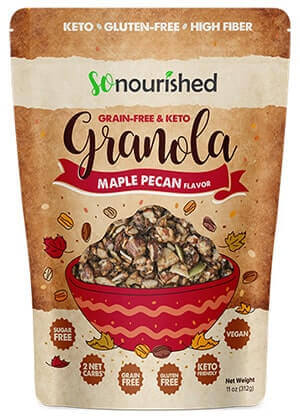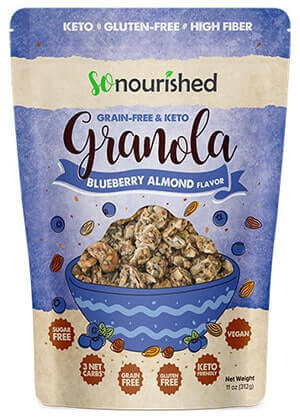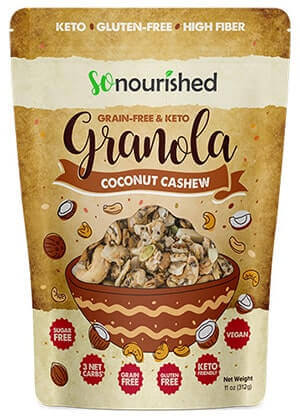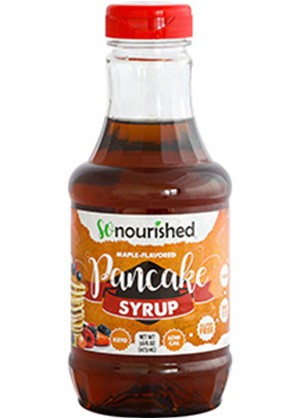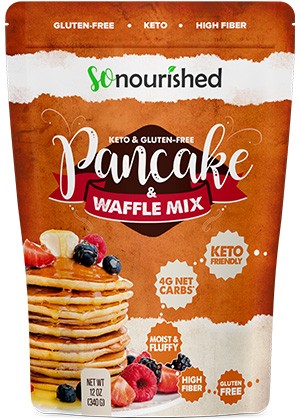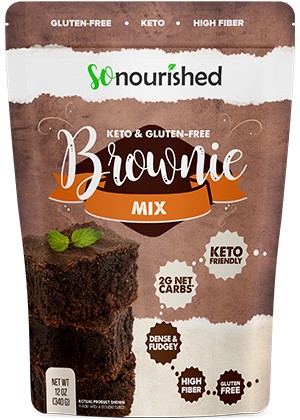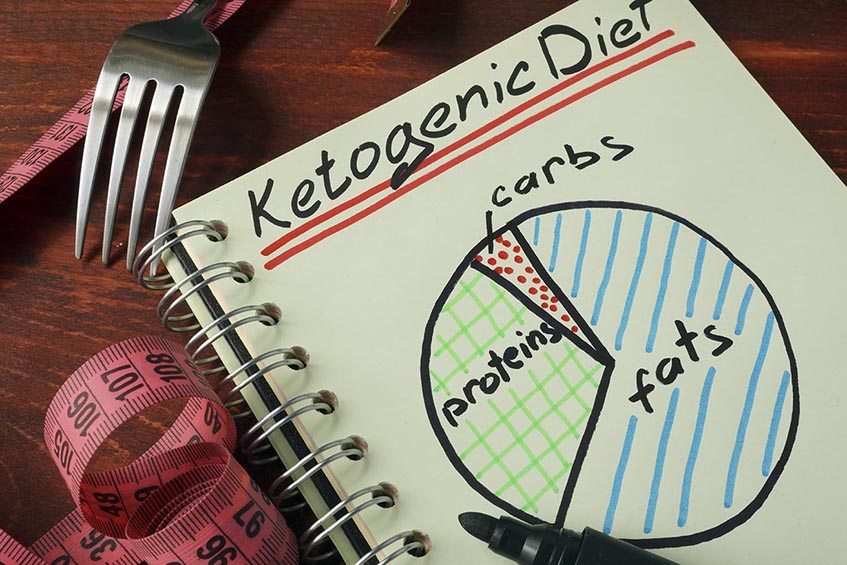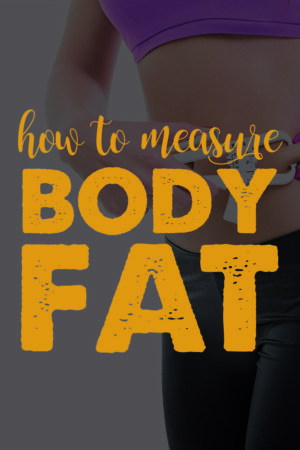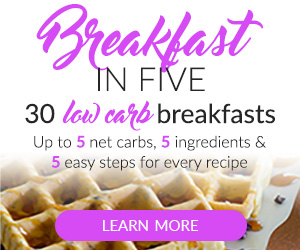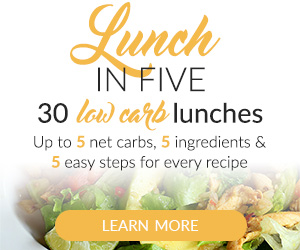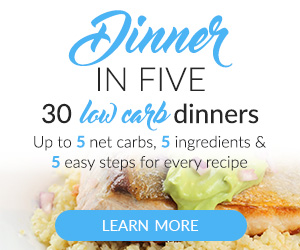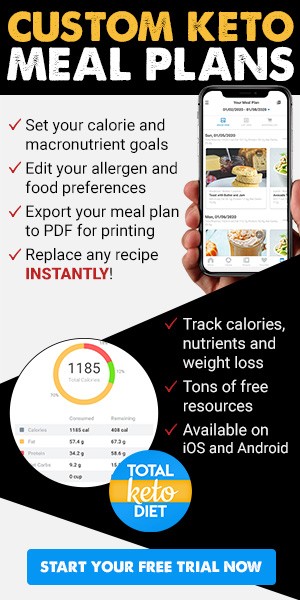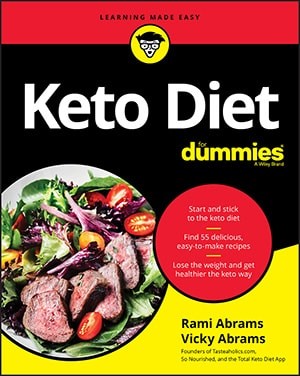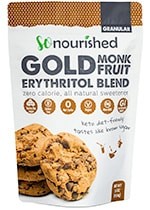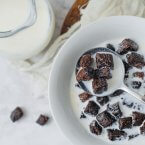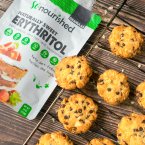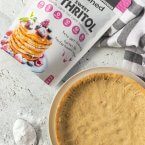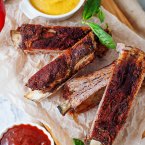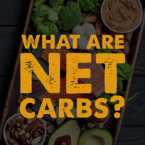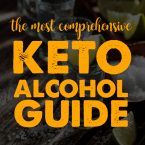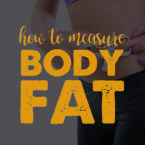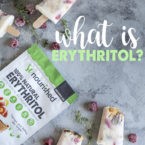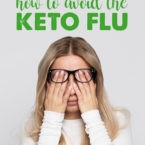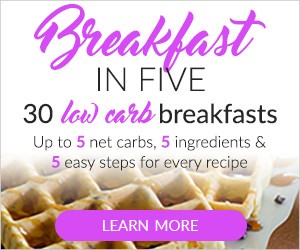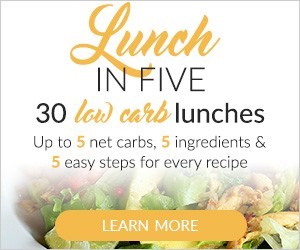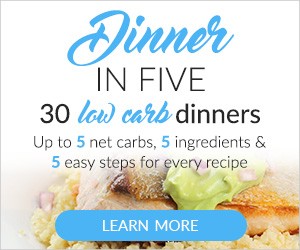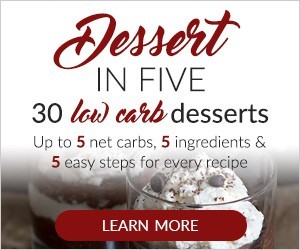Keto Diet Basics
The keto diet (also known as a ketogenic diet, low carb diet or LCHF) is a diet where you eat very few carbohydrates and plenty of healthy fats and protein. It is the only diet which not only helps its users with significant weight loss but also reduces the risk of developing a variety of chronic health conditions like Alzheimer’s,1 heart disease,2,3 prediabetes,4 Parkinson's,5 type 2 diabetes,6 and much more.7
How A Keto Diet Works
Normally, when eating lots of carbs, the body runs primarily on glucose (which is derived from carbohydrates). This metabolic state is called glycolysis. On a keto diet, the body runs on ketones, an energy source derived from fat. The metabolic state when running on ketones is called ketosis – hence the name keto diet! To achieve ketosis, it typically takes between three to five days of eating under 30 grams of carbohydrates. Once in ketosis, the body will use fat (whether stored or consumed), rather than carbs for energy.
So, when you start transitioning to eating a low-carb and high-fat diet, how do you know if the ketogenic diet is working for you? One of the easiest ways to find out would be to use ketone test strips a few days after starting a keto diet to test your urine for excess ketone bodies. If the strip changes colors, you know the keto diet is working and you’ve entered ketosis. You can also determine if you’re in ketosis by listening to your body. Ketosis indicators include changes in your attentiveness and temperament, better sleep patterns, a minimized appetite and strong smell in your urine and breath.
Ketogenic Diet 101
When on a ketogenic diet, most consumed calories (between 65 and 75 percent) should be from the fat you eat. The next largest portion would be protein (around 20 to 25 percent), followed by carbohydrates at only around 5 percent.
For those unfamiliar with this concept, the first thought that comes to mind is that eating fat is bad for you. However, many studies have shown that most of the fats we consume are vital to our health, while excess carbs are hurting us.
What Are Carbs?
Carbs are found in foods high in sugar, starches, and grains (like pasta, cereals, burgers, soda and more) and cause a spike in one’s blood sugar levels since they turn to glucose as the body breaks them down. In turn, our bodies must release insulin to reduce blood sugar levels and stabilize us. Overconsumption of these foods and the consistent spike and crash of blood sugar levels can lead to insulin insensitivity, which eventually leads to pre-diabetes and type 2 diabetes.
Excessively sugary foods and carb-focused diets have been detrimental to our health. According to the CDC, more than 86 million people in the United States have pre-diabetes and almost 10 percent of American adults have type 2 diabetes. These figures have increased by more than 4 times since the 1970s. This diabetic trend started in the 70s because the USDA and FDA started recommending carbs to be our primary source of energy, saying that they should make up the largest percentage of calories in our daily diets.
This has resulted in food manufacturers replacing the fat in packaged foods with chemical alternatives to make them “healthier” in the forms of low-fat and fat-free options. This hasn’t stopped the trend, so clearly, this isn’t the answer to solving society’s health problems.
Fatty acids, or fats, and amino acids, or protein, are necessary for human survival. The term “essential carbohydrate” simply does not exist. In addition, the most efficient energy comes from fat (one gram is 9 calories) in comparison to a gram of carbohydrates (4 calories). This is a big part of why our bodies store fat in the first place.
Calorie and Macronutrient Basics
Calories and macronutrients are also very important to the success of this diet. Calories translate to energy, which in turn determine how much weight you gain or lose. For example, if you eat 2,000 calories worth of food per day while only burning 1,800 calories, you will end up gaining weight, whereas if you burned 2,100 calories you would lose weight. This basic in-vs-out formula works on any diet.
However, there’s more to the keto diet than just calorie counting. Macronutrients, also known as macros, are what make up the foods we eat and the calories we take in. Every food is made from fat, protein and/or carbs. Each macronutrient contains a specific amount of calories your body can use as energy:
- Fat = 9 calories per gram
- Protein = 4 calories per gram
- Carbohydrates = 4 calories per gram
- Alcohol = 7 calories per gram
On the keto diet, the balance of macronutrients eaten goes roughly like this:
- Fat: 70% of your calories
- Protein: 25% of your calories
- Carbohydrates: 5% of your calories
If eating approximately 2000 calories a day (this number varies from person-to-person), you would eat:
- 155.5 grams of fat (9 calories per gram * 155.5 grams = about 1400 calories)
- 125 grams of protein (4 calories per gram * 125 grams = 500 calories)
- 25 gram of carbohydrates (4 calories per gram * 25 grams = 100 calories)
If you'd to find out exactly how many calories and which macros you should be eating day-to-day based on your body type and goals, please use this keto calculator.
Results and Benefits
Consuming lower amounts of carbs and higher amounts of fats has some major health benefits.

Short-term benefits include:
- Losing weight
- Having increased energy throughout the day
- Feeling fuller longer
- Snacking less
- An all-around happier lifestyle
Because most of the consumed calories are derived from fat, it takes longer to digest leading to more consistent levels of energy throughout the day. Lowering the number of carbs eliminates unhealthy and inconsistent blood glucose crashes that throw you for a downward spiral in the middle of your day.
In addition to these immediate and short-term benefits, there are some impressive long-term benefits that should certainly inspire you to change your lifestyle right away. Here are just a few:
- Improved levels HDL and large LDL cholesterol
- Decreases risk of dangerous chronic conditions like heart disease and high blood pressure
- Lowers risk for heart attacks or strokes
- Reverses prediabetes and type 2 diabetes
- Severely reduces seizures for those suffering from epilepsy (especially in children)
Type 1 Diabetes
If you have type 1 diabetes, start a conversation with your doctor about switching to a keto diet. They will need to closely monitor you, in the beginning, to adjust and lower your insulin dosage accordingly (since your blood sugar will not rise like before). Do not start a keto diet without your doctor's supervision.
Keto Flu
Keto flu is a common side effect in the very beginning of the keto diet which happens due to lowered sodium and electrolyte levels. This typically happens due to cutting out processed foods, which are higher in sodium, and the depletion of glycogen (which flushes water). Symptoms include feeling lightheaded, fatigued, irritable, nauseous and other feelings similar to the flu.
However, it's important to keep in mind that this isn't the real flu! Consuming enough electrolytes and watching your sodium intake makes this easily avoidable. Add a little more salt to foods, especially in the beginning, drink broth or pickled foods, and enjoy plenty of cured meats like bacon. Also, remember to drink plenty of water.
Eating this way at the beginning of your transition onto the diet will ensure you forgo getting this faux flu altogether. If you do catch it though, don’t let it discourage you! The feeling will only be temporary and you're still on your way to becoming a fat-burning machine!
How to Start the Keto Diet
The goal of this incredible lifestyle change is to maintain a state of nutritional ketosis consistently. When first starting out, you will want to begin by eating only up to 25 grams of net carbs per day. Net carbs are total carbs minus any dietary fiber (soluble or insoluble) and sugar alcohols (like erythritol, xylitol, maltitol, etc.).
After a month or two of eating in this manner and staying in ketosis, you’ll become what is referred to as keto- or fat-adapted. You’ll also notice how much your endurance and levels of energy have increased day-to-day. Once you’ve reached this point, you can begin to introduce higher amounts of carbs into your diet if you would like, with a maximum of 50 grams of net carbs per day.
What to Eat
A successful diet only happens if you fully prepare, both mentally and physically, for the venture. The foods below are tasty, wholesome and of course, keto-friendly. They'll jumpstart the renewed, healthier, & more energetic you!

Meat, Fish & Eggs
All are ideal to eat when on the keto diet. Freely eat chicken, beef, eggs, salmon, tuna, pork, lamb, turkey, etc. If possible, try to buy your meats grass-fed or organic and your seafood wild-caught. There’s also no limit to the number of organic eggs you can eat.
Dairy
In terms of dairy, full-fat options are fully encouraged including heavy cream, all kinds of cheeses, butter, sour cream and yogurt (but make sure it’s unsweetened). Replace milk with almond milk, cashew milk or coconut milk.
Try to avoid skim milk, sweetened high sugar yogurt and regular milk, since the amount of sugar can throw off your efforts. And of course, do not buy the fat-free or low-fat options for any of your dairy.
Oils & Fats
For cooking, you are encouraged to cook all your meals with olive oil, avocado oil, coconut oil, butter, or bacon fat.

Vegetables
Eat unlimited non-starchy vegetables such as broccoli, cauliflower, mushrooms, asparagus, zucchini, Brussels sprouts, onions, green beans, cucumbers, tomatoes, garlic, etc. Just avoid corn, potatoes, and sweet potatoes.
Fruits
The amount of fruit that should be consumed, due to the sugar, is minimal. Most berries are okay including raspberries, blackberries, blueberries, and strawberries in limited quantities.
Eat avocados (avocado is a fruit!) freely as well since they’re both low-carb and high-fat!
Sauces
Mayonnaise, mustard, pesto, and sriracha can all be used to enhance your meals.
Seeds & Nuts
Seeds and nuts are perfect for snacking including pecans, almonds, walnuts and macadamia nuts.
Sweeteners
Use stevia, erythritol or monk fruit as your sweeteners. Erythritol is a sugar alcohol with 0 calories and 0 net carbs (sugar alcohols aren't digested by our bodies, much like dietary fiber). Other sweeteners like maltitol or sorbitol can quickly upset your stomach and cause bloating and cramping.
Beverages
For beverages, feel free to consume all the water, coffee and tea your heart desires. Low-carb drinks like Bai are great as well (they use erythritol as their sweetener).
What Not to Eat
The best approach is to begin the keto diet by throwing out all those foods that are unhealthy, tempting and do not fit with your new lifestyle. This can be the most major part of successfully beginning the keto diet as you remove any temptations to veer off course.
Anything Sugary
If there’s anything that’s in your home like desserts, sodas, pastries, candy, fruit juices or refined sugars, get rid of it immediately. Temptations are extremely difficult to beat when you have easy access to what you're craving.
Grains and Starches
Cereal, pasta, bagels, flour, corn, potatoes, oats, rice, bread, wraps–anything in this family of foods also needs to go.
Seed and Vegetable Oils
Do not cook with any of the following types of oil: soybean, canola, sunflower, corn, or grapeseed. Discard any margarine. Butter is healthy and much better to use.
Legumes
Legumes such as beans, peas, and lentils should all also be removed.
Time to Get Started
Now that you’re armed with all the knowledge of how to successfully start the keto diet, it’s time to get started!
Be sure to check the nutrition labels when heading to the grocery store to apply the lessons you’ve learned and ensure what you're buying is not high in carbs. Make sure you understand and calculate the appropriate serving size the label is referring to for each of the elements. You can use a handy app like Total Keto Diet to do the calculations for you.
In the beginning, read all labels because tons of foods you'd never expect to be high-carb are very high-carb (such as ketchup and creamy canned soups). They would totally reverse all your efforts. If you can’t read or understand the ingredients, just don't buy it!
Changing your lifestyle and eating habits to those outlined in the keto diet will result in a life filled with health, happiness and lots of energy – guaranteed.
References
- Henderson, S. T. “High Carbohydrate Diets and Alzheimer’s Disease.” Medical Hypotheses 62, no. 5 (2014): 689 –700. doi:10.1016/j.mehy.2003.11.028. www.ncbi.nlm.nih.gov/pubmed/15082091.
- Chowdhury R, “Association of dietary, circulating, and supplement fatty acids with coronary risk: a systematic review and meta-analysis.” Ann Intern Med. 2014 May 6;160(9):658. https://www.ncbi.nlm.nih.gov/pubmed/24723079.
- Siri-Tarino, P. W., Q. Sun, F. B. Hu, and R. M. Krauss. “Meta-Analysis of Prospective Cohort Studies Evaluating the Association of Saturated Fat with Cardiovascular Disease.” American Journal of Clinical Nutrition 91, no. 3 (March 2010): 535–46. doi:10.3945/ajcn.2009.27725. www.ncbi.nlm.nih.gov/pubmed/20071648.
- Westman, Eric C. “Insulin Resistance from a Low Carbohydrate, High Fat Diet Perspective.” Metabolic Syndrome and Related DisordersVol. 3, No. 1. https://www.liebertpub.com/doi/abs/10.1089/met.2005.3.14?journalCode=met.
- De Lau, L. M., M. Bornebroek, J. C. Witteman, A. Hofman, P. J. Koudstaal, and M. M. Breteler. “Dietary Fatty Acids and the Risk of Parkinson Disease: The Rotterdam Study.” Neurology 64, no. 12 (June 2005): 2040–5. doi:10.1212/01.WNL.0000166038.67153.9F. www.ncbi.nlm.nih.gov/pubmed/15985568/.
- Wing, Rena R. “Year-long weight loss treatment for obese patients with type II diabetes: Does including an intermittent very-low-calorie diet improve outcome?” American Journal of Medicine Volume 97, Issue 4, P354-362. https://www.amjmed.com/article/0002-9343(94)90302-6/pdf.
- Aude, Y., A. S, Agatston, F. Lopez-Jimenez, et al. “The National Cholesterol Education Program Diet vs a Diet Lower in Carbohydrates and Higher in Protein and Monounsaturated Fat: A Randomized Trial.” JAMA Internal Medicine 164, no. 19 (2004): 2141–46. doi: 10.1001/archinte.164.19.2141. jamanetwork.com/journals/jamainternalmedicine/article-abstract/217514.
NUTRITIONAL DISCLAIMER
The content on this website should not be taken as medical advice and you should ALWAYS consult with your doctor before starting any diet or exercise program. We provide nutritional data for our recipes as a courtesy to our readers. We use Total Keto Diet app software to calculate the nutrition and we remove fiber and sugar alcohols, like erythritol, from the total carbohydrate count to get to the net carb count, as they do not affect your blood glucose levels. You should independently calculate nutritional information on your own and not rely on our data. The website or content herein is not intended to cure, prevent, diagnose or treat any disease. This website shall not be liable for adverse reactions or any other outcome resulting from the use of recipes or recommendations on the Website or actions you take as a result. Any action you take is strictly at your own risk.
- What Is Erythritol? The Keto Sugar Substitute - April 24, 2020
- Ketone Strips, Keto Sticks & Meters – Calculate Your Ketones - January 9, 2018
- What Are Macros? - December 29, 2017


